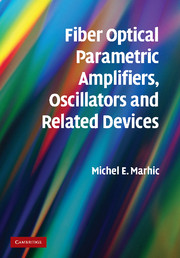Book contents
- Frontmatter
- Contents
- Acknowledgments
- 1 Introduction
- 2 Properties of single-mode optical fibers
- 3 Scalar OPA theory
- 4 Vector OPA theory
- 5 The optical gain spectrum
- 6 The nonlinear Schrödinger equation
- 7 Pulsed-pump OPAs
- 8 OPO theory
- 9 Quantum noise figure of fiber OPAs
- 10 Pump requirements
- 11 Performance results
- 12 Potential applications of fiber OPAs and OPOs
- 13 Nonlinear crosstalk in fiber OPAs
- 14 Distributed parametric amplification
- 15 Prospects for future developments
- Appendices
- Index
- References
15 - Prospects for future developments
Published online by Cambridge University Press: 23 March 2010
- Frontmatter
- Contents
- Acknowledgments
- 1 Introduction
- 2 Properties of single-mode optical fibers
- 3 Scalar OPA theory
- 4 Vector OPA theory
- 5 The optical gain spectrum
- 6 The nonlinear Schrödinger equation
- 7 Pulsed-pump OPAs
- 8 OPO theory
- 9 Quantum noise figure of fiber OPAs
- 10 Pump requirements
- 11 Performance results
- 12 Potential applications of fiber OPAs and OPOs
- 13 Nonlinear crosstalk in fiber OPAs
- 14 Distributed parametric amplification
- 15 Prospects for future developments
- Appendices
- Index
- References
Summary
Introduction
In the preceding chapters we have reviewed the state of the art in fiber OPAs, in terms of the current theoretical understanding and of their experimental performance and progress toward applications. Along the way we have identified a number of obstacles that stand in the way of further progress. In this chapter we review some areas of technology where advances would be desirable for the development of fiber OPAs or related devices. We also look at areas that have not been investigated much to date and may yet present interesting research and development opportunities.
Fibers
Conventional fiber structures, consisting of a cylindrical core surrounded by a cladding made from a lower-index material, offer limited opportunities for optimizing the fiber properties of fiber OPAs. In contrast, as mentioned in Section 2.1, holey fibers (HFs) have the potential for providing new generations of fibers suitable for fiber OPAs. In principle all HF properties, including loss, nonlinear index, mode effective area, and dispersion, can be optimized. To improve OPA performance significantly beyond the level reached with currently available fibers, all properties will eventually need to be simultaneously optimized in the same HF. This will pose an interesting challenge for the designers and manufacturers of HFs.
High-γ fibers
A large value of the fiber nonlinearity coefficient γ (see Eq. (2.24)) is beneficial in a number of ways. It makes it easier to obtain a large gain bandwidth at moderate pump power. It also reduces the product P0L required to achieve a given gain.
- Type
- Chapter
- Information
- Publisher: Cambridge University PressPrint publication year: 2007



